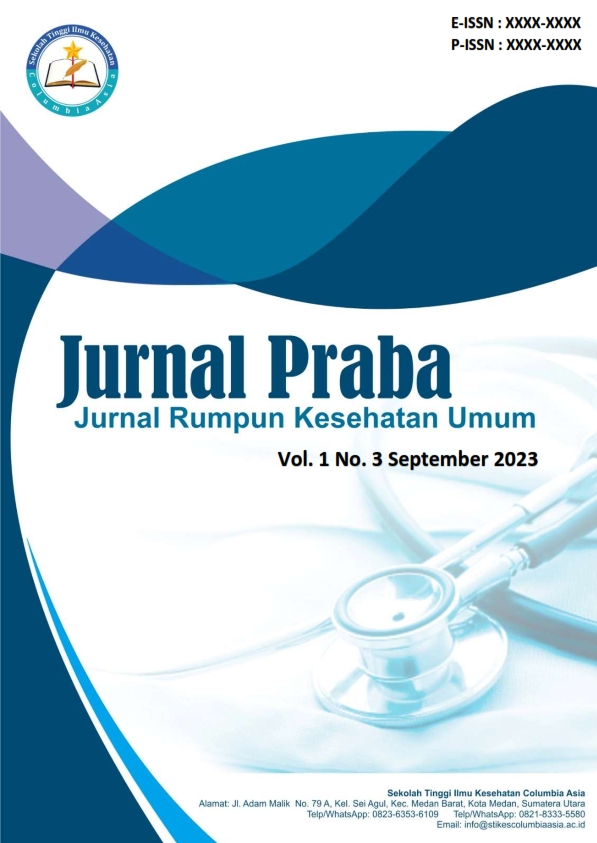Spasial TB. Paru BTA (+) Pada Puskesmas Hc. Kedaton Kecamatan Kedaton Bandar Lampung
DOI:
https://doi.org/10.62027/praba.v3i3.547Keywords:
Aerosol, population density, slum, Mycobacterium tuberculosis, spatial analysisAbstract
Mycobacterium tuberculosis is characterized by a thick, mycolic acid–rich cell wall that confers hydrophobicity, chemical resistance, and environmental stability, making cell wall biosynthesis inhibitors a major therapeutic target. Tuberculosis is not only a medical condition but also a social disease linked to high population density, malnutrition, and limited healthcare access. In 2023, Kedaton District was identified as the most densely populated area in Bandar Lampung, increasing the likelihood of pulmonary TB smear-positive (TB.Paru BTA+) transmission. Aerosol spread is highly distance-dependent: direct exposure within 0–1 meter poses very high risk, and WHO reports indicate that exposure <1 meter for ≥15 minutes in enclosed spaces significantly elevates infection risk, extending up to 5–10 meters without ventilation. This study employed spatial analysis to measure inter-household distances among 75 TB.Paru BTA(+) patients using Euclidean distance and smartphone-based field surveys. The method proved suitable for small-scale studies with high data accuracy, though resource-intensive for larger populations. Findings revealed some households only 3 meters apart, but this observation was not yet statistically significant to confirm transmission dynamics.
References
Acuña-Villaorduña, C. (2018). Intensity of exposure to pulmonary tuberculosis determines risk of tuberculosis infection and disease. European Respiratory Journal, 51(1).
Arulmohi, M. (2017). Prediction Model of Tuberculosis Transmission Based on Its Risk Factors and Socioeconomic Position in Indonesia. Indian Journal of Community Medicine, 42(1), 147-50.
Carpenter, D. (2024.). The Effec to fPopulation Density on The Risk of Tuberculosis in Densely Populated Environments. journal of Diverse Medical Research, 259-264.
Centers for Disease Control and Prevention, A. G. (2020). A Neighbor-Based Approach to Identify Tuberculosis Exposure, the Kopanyo Study - Volume 26, Number 5—May 2020 - Emerging Infectious Diseases journal - CDC. Emerging Infectious Diseases, 26.
Chen, W. (2013). Pulmonary Tuberculosis Incidence and Risk Factors in Rural Areas of China: A Cohort Study. PLoS ONE, 8(3), 1-7.
Davoudi-Kiakalayeh, A. (2017). Alloimmunization in thalassemia patients: New insight for healthcare. International Journal of Preventive Medicine, 1-7.
Escombe, A. R. (2007). Natural ventilation for the prevention of airborne contagion. PLoS Medicine, 0309-0317.
Escombe, A. R. (2007). Natural ventilation for the prevention of airborne contagion. PLoS Medicine, 0309-0317.
Fennelly, K. (2020). Particle sizes of infectious aerosols: implications for infection control,. The Lancet Respiratory Medicine, 914-924.
Helmy, H. (2022). Investigating Spatial Patterns of Pulmonary Tuberculosis and Main Related Factors in Bandar Lampung, Indonesia Using Geographically Weighted Poisson Regression. Tropical Medicine and Infectious Disease.
Huang, C. C. (2022). Spatial scale of tuberculosis transmission in Lima, Peru. Proceedings of the National Academy of Sciences of the United States of America, 1-6.
IsJiang, H. (2022). Distribution of bacteriologically positive and bacteriologically negative pulmonary tuberculosis in Northwest China: spatiotemporal analysis. Scientific Reports, 1-11.
Jiang, H. (2022). Distribution of bacteriologically positive and bacteriologically negative pulmonary tuberculosis in Northwest China: spatiotemporal analysis. Scientific Reports, 1-11.
Lee, J. Y. (2022). Inadequate housing and pulmonary tuberculosis: a systematic review. BMC Public Health, 22(1), 1-12.
Lee, J. Y. (2022). Inadequate housing and pulmonary tuberculosis: a systematic review. BMC Public Health, 22(1), 1-12.
Liu, L. (2017). Short-range airborne transmission of expiratory droplets between two people. indoor Air, 452-462.
Liyew, A. M. (2024). Ecological-level factors associated with tuberculosis incidence and mortality: A systematic review and meta-analysis. PLOS Global Public Health, 1-22.
Martinez, L. (2017). Transmission of Mycobacterium Tuberculosis in Households and the Community: A Systematic Review and Meta-Analysis. American Journal of Epidemiology, 185(12), 1327-1339.
Moonan, P. K. (2020). A neighbor-based approach to identify tuberculosis exposure, the Kopanyo study. Emerging Infectious Diseases, 1010-1013.
Mustofa, Z. (2020). Algoritma Clustering K-Medoids Pada E-Government Bidang Information and Communication Technology Dalam Penentuan Status Edgi. Jurnal Teknologi Informasi Dan Komunikasi, 9, 1-10.
Nurjana, M. A. (2019). Risiko tuberculosis paru pada balita di daerah kumuh Indonesia. Pros Poltekkes Kemenkes Palu, 2019, 1(1), 18-29.
Sari, D. (2022). Gambaran Sanitasi Dan Perilaku Penghuni Rumah Penderita Tuberkulosis Di Wilayah Kerja Puskesmas Kedaton Kota Bandar Lampung Tahun 2021. Ruwa Jurai: Jurnal Kesehatan Lingkungan, 138.
Soares, P. (2022). Ecological factors associated with areas of high tuberculosis diagnosis delay. Public Health, 32-39.
Wingfield, T. (2014). The seasonality of tuberculosis, sunlight, vitamin D, and household crowding. Journal of Infectious Diseases, 774-783.
Zhang, Q. (2022). An Ecological Study of Tuberculosis Incidence in China, From 2002 to 2018. Frontiers in Public Health, 1-8.
Zhang, Q. (2022). An Ecological Study of Tuberculosis Incidence in China, From 2002 to 2018. Frontiers in Public Health, 1-8.
Downloads
Published
How to Cite
Issue
Section
License
Copyright (c) 2025 Jurnal Praba : Jurnal Rumpun Kesehatan Umum

This work is licensed under a Creative Commons Attribution-ShareAlike 4.0 International License.







